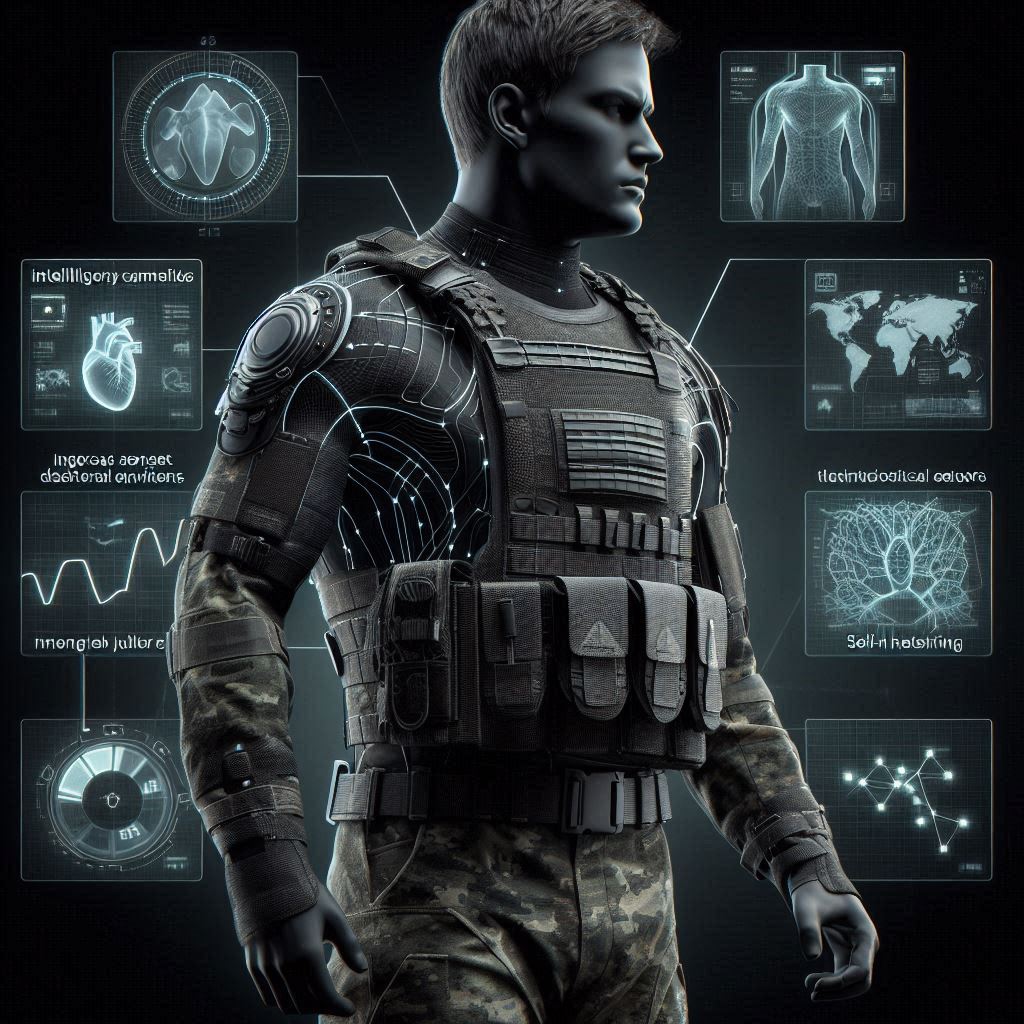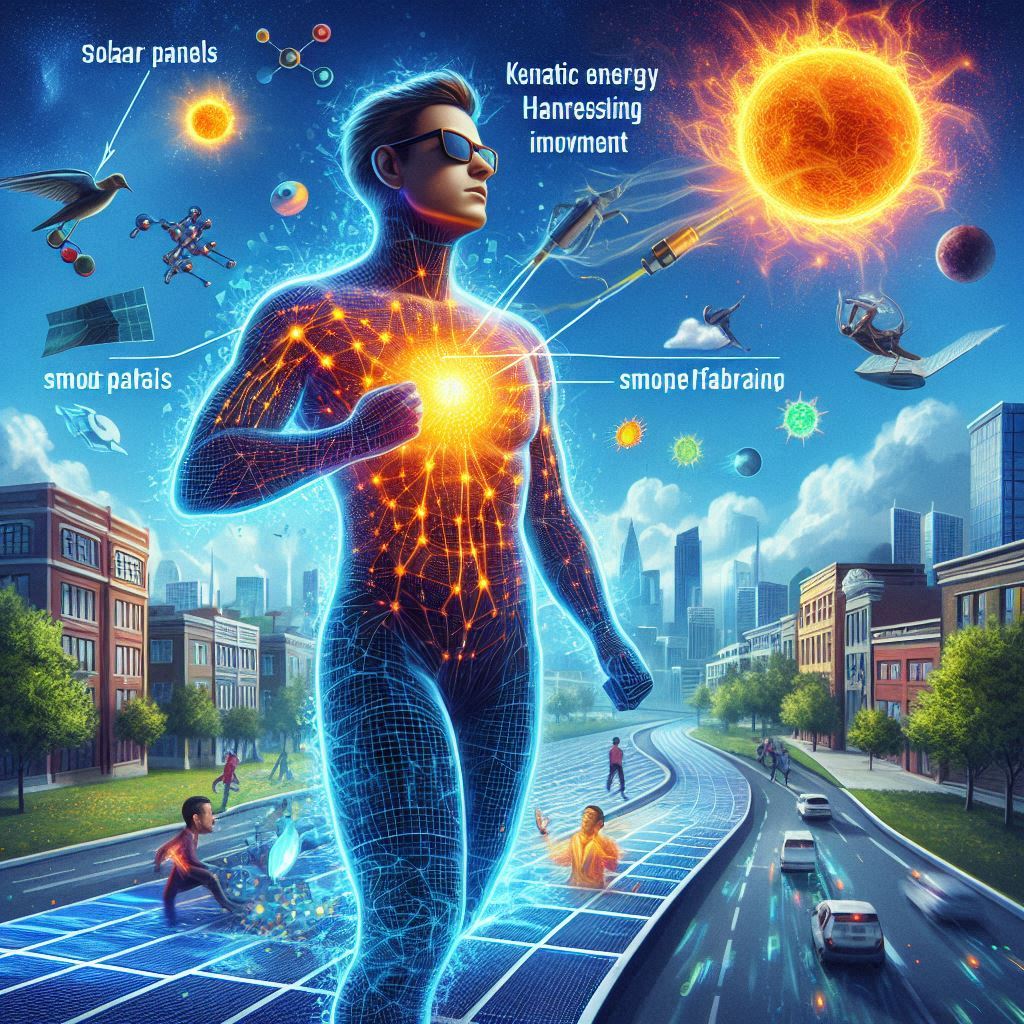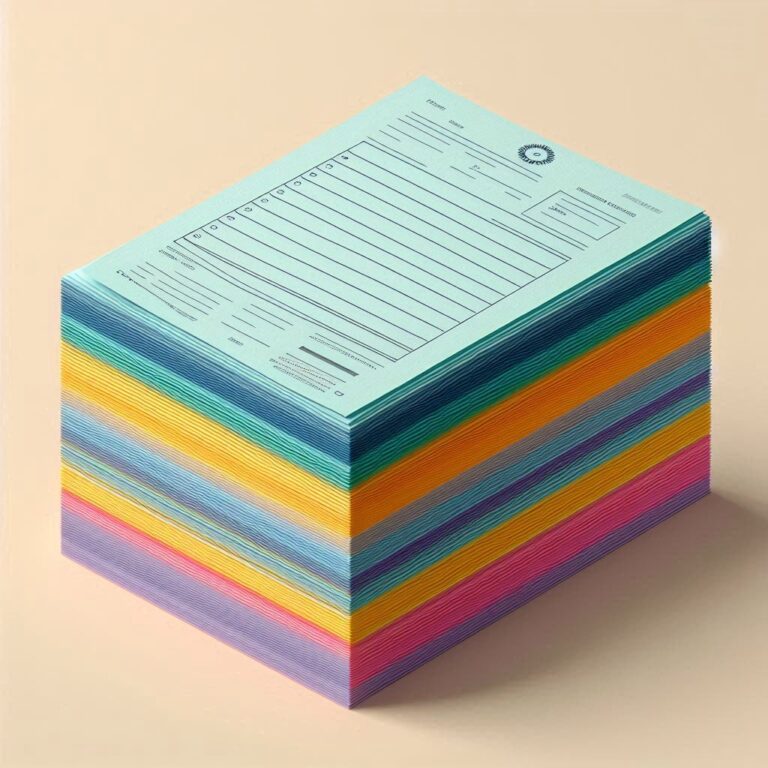How Smart Fabrics Will Revolutionize the Way We Dress
Imagine this: You’re hitting the gym, completely immersed in your workout. But unlike usual, your clothes are working right alongside you. A built-in fitness tracker in your shirt monitors your heart rate and exertion, while your sneakers adjust to provide optimal cushioning for every step.
Now, this isn’t just a scene from a sci-fi movie. This is the exciting world of smart fabrics and intelligent textiles, where technology seamlessly integrates with fashion to create clothing that’s not just stylish, but functional and responsive to your needs.

For centuries, textiles have served as a basic human necessity, providing protection and self-expression. But traditional clothing often falls short of addressing our evolving needs. It can be ill-equipped for extreme weather, lack key functionalities, and require constant replacement.
What are Smart Fabrics and Intelligent Textiles?
Enter smart fabrics. These innovative materials are woven with the magic of technology, using electronic components to create garments that are anything but ordinary. Imagine jackets that keep you warm in the winter and cool in the summer or shirts that monitor your health vitals. The possibilities are truly endless.
So, how exactly do these textiles work? Smart fabrics incorporate various elements, including conductive fibers, sensors, and actuators. Conductive fibers act like tiny wires, allowing electrical signals to travel throughout the garment. Sensors pick up information about your body or the environment, such as temperature or pressure. Finally, actuators translate those signals into a response, like making a jacket adjust its temperature or shoes adapt to your terrain.
By the end of this blog post, you’ll be well-versed in the fascinating world of smart fabrics and intelligent textiles. We’ll delve deeper into the different types of smart fabrics, explore their applications, and discuss the future of this revolutionary technology. So, buckle up and get ready to explore the exciting intersection of fashion and functionality!
From Fitness Trackers to Self-Heating Jackets: Unveiling the Applications of Tech Fashion
Gone are the days when clothing served solely as a form of protection and self-expression. Today, we’re witnessing the rise of tech fashion, where cutting-edge fabrics are woven with technology to create garments that are both stylish and functional. But what exactly are the applications of these smart fabrics? Let’s embark on a journey to explore how tech fashion is revolutionizing various sectors:
Sportswear and Fitness Apparel:
Imagine a workout session where your clothes become an extension of your own body. Smart sportswear is transforming the fitness landscape by integrating sensors directly into the fabric. These sensors can monitor your heart rate, track performance metrics like distance and speed, and even analyze your running form. Real-time feedback on your smartphone allows you to optimize your training and push your limits safely.
Athleisure Clothing:
The athleisure trend isn’t just about blending style and comfort. Advancements in smart fabrics are making athleisure even more versatile. Imagine clothes that wick away sweat efficiently during your morning run and then seamlessly transition to a comfortable outfit for the rest of your day. These garments utilize moisture-wicking materials and temperature-regulation technology to keep you cozy in various environments.
Medical Wearables:
Tech fashion is making significant strides in the medical field. Smart garments embedded with sensors can monitor vital signs like heart rate, blood pressure, and even blood oxygen levels. This real-time data can be crucial for individuals with chronic conditions or those undergoing rehabilitation. Additionally, compression garments with built-in sensors can promote faster muscle recovery and improve circulation.

Real-world example: Empatica’s E3 wristband is a medical-grade device disguised as a stylish bracelet. It continuously monitors physiological signals like heart rate, electrodermal activity (EDA), and skin temperature, providing valuable data for managing epilepsy, sleep disorders, and stress.
Workwear and Uniforms:
The world of work is also embracing the power of smart fabrics. Imagine construction workers wearing jackets with built-in environmental sensors that monitor dust levels or firefighters equipped with uniforms that can detect extreme heat. Tech fashion can enhance safety features in workwear by incorporating reflective materials, impact-resistant elements, or even integrating communication devices directly into the clothing.
Real-world example: DuPont’s Nomex® material is a flame-resistant fabric used in firefighter uniforms. Now, they’re developing Xpert Shield, a smart fabric that incorporates sensors to detect hazardous gases and alert firefighters to potential dangers.
Military and Tactical Applications:
The military is constantly seeking advancements in technology for soldier protection and performance. Camouflage that adapts to different environments, protective gear with integrated physiological sensors to monitor soldier well-being, or self-heating clothing for extremely cold conditions are just a few possibilities that tech fashion brings to the table.

Real-world example: The US Army is exploring electronic textiles for use in battlefield bandages that can monitor wound healing and prevent infection. This technology has the potential to revolutionize battlefield medicine and improve soldier care.
Everyday Clothing:
The future of tech fashion isn’t just about specialized garments. Imagine everyday clothing that regulates your body temperature, adjusts to your posture for improved ergonomics, or even interacts with your smartphone to personalize your experience. These advancements are still under development, but the possibilities are truly endless.
Tech fashion is not just a passing fad; it’s a transformative movement shaping the future of clothing. As technology continues to evolve, we can expect even more innovative applications for smart fabrics, blurring the lines between fashion and functionality and creating a world where our clothes become an integral part of our connected lives.
The Benefits of Tech Fashion: A Look Beyond the Fabric
Tech fashion isn’t just about fancy gadgets sewn into clothes. It’s about a revolution in how we interact with what we wear. Smart fabrics offer a plethora of advantages that extend far beyond the material itself, transforming our clothing into active partners in our well-being, safety, and even style. Let’s delve deeper into the ways tech fashion benefits wearers:
Enhanced Comfort and Wearability:
Imagine stepping outside on a chilly morning and your jacket automatically adjusts to keep you warm. Or picture clothing that wicks away moisture during exercise, keeping you cool and dry. Tech fashion offers a new level of comfort by utilizing features like temperature regulation, moisture management, and even posture-correcting technology. These advancements can significantly improve our daily experiences, making us feel more comfortable and confident throughout the day.

Health and Fitness Monitoring:
Tech fashion isn’t just about looking good; it can also help you feel your best. Smart fabrics embedded with sensors can track a range of health metrics, from heart rate and blood pressure to sleep patterns and activity levels. This real-time data empowers you to understand your body better, optimize your workouts, and even receive alerts for potential health concerns. Fitness trackers woven into clothing eliminate the need for bulky wearables, seamlessly integrating health monitoring into your daily routine.
Safety Features:
Safety is paramount, and tech fashion is stepping up to the challenge. Imagine clothes that can detect falls in the elderly and automatically alert emergency services. For athletes or construction workers, garments with built-in impact sensors can provide valuable data on potential injuries. Tech fashion even has the potential to create clothing with built-in airbags or reflective materials for enhanced visibility in low-light conditions.
Environmental Awareness:
With growing concerns about climate change and pollution, tech fashion is offering solutions for a more sustainable future. Imagine clothes that monitor air quality or UV radiation exposure, allowing you to make informed decisions about your activities. Additionally, smart fabrics with self-cleaning properties can reduce the need for frequent washing, lowering water consumption and energy usage.

Personalization and Customization:
Tech fashion caters to the individual. Imagine clothes that adjust to your personal preferences, like color schemes that change based on your mood or clothing that tailors to your body measurements. Smart fabrics with integrated displays can allow for personalized messages or notifications, making your clothing a true extension of your unique style.
The benefits of tech fashion extend far beyond aesthetics. It’s about creating clothing that is intelligent, responsive, and seamlessly integrated into our lives. As technology continues to evolve, we can expect even more innovative features and applications for smart fabrics, ushering in a future where fashion meets functionality to create a truly personalized and beneficial experience for everyone.
Challenges and Considerations: Weaving a Sustainable Future for Tech Fashion
Tech fashion is undeniably exciting, but like any burgeoning industry, it faces hurdles that need to be addressed to ensure a truly sustainable future. Here’s a closer look at some of the key challenges and the ongoing research efforts to overcome them:
Durability and Washability:
One of the biggest concerns surrounding smart fabrics is their ability to withstand the rigors of everyday wear. Integrating electronics into textiles can compromise their durability, and washing instructions can become complex due to delicate components.
Current Research:
- Scientists are developing new, more robust conductive materials and exploring ways to better integrate electronics into fabrics without compromising their strength and flexibility.
- Research into “washable electronics” is ongoing, with advancements in waterproof coatings and innovative manufacturing processes that can withstand traditional washing methods.
Power Source and Battery Life:
Powering the electronics woven into smart garments presents a significant challenge. Bulky batteries or frequent recharging can be inconvenient and limit the appeal of tech fashion.

Current Research:
- Researchers are exploring alternative power sources like solar panels, kinetic energy harvesting from movement, and even body heat.
- Advancements in battery technology are focusing on miniaturization, improved energy density, and even self-charging capabilities.
Data Privacy and Security:
The data collected by smart clothing raises concerns about user privacy and security. Sensitive health information or personal activity data needs robust protection from unauthorized access.
Current Research:
- Secure data encryption methods are being developed to ensure the confidentiality and integrity of user data collected by smart fabrics.
- Blockchain technology is being explored as a potential solution for secure data storage and management in the context of wearable tech.
Cost and Affordability:
The integration of technology into textiles significantly increases production costs, making tech fashion a luxury for many consumers.
Current Research:
- Researchers are focusing on developing more cost-effective materials and manufacturing processes to bring down the price point of smart fabrics.
- The rise of open-source platforms and collaborative research efforts aim to accelerate innovation and make tech fashion more accessible.
Sustainability and Environmental Impact:
The production of tech fashion can have an environmental impact similar to traditional electronics. E-waste management and the potential for microplastics from these fabrics pose challenges.
Current Research:
- The use of recycled materials and biodegradable components in smart fabrics is being actively explored.
- Researchers are developing end-of-life solutions for tech fashion, focusing on disassembly and responsible recycling of electronic components.
By addressing these challenges through ongoing research and innovation, the tech fashion industry can move towards a more sustainable future. By focusing on durability, sustainable power sources, robust data security, affordability, and responsible manufacturing practices, we can create smart clothing that benefits both wearers and the planet.
The Future of Intelligent Textile: A Collaborative Effort
Tech fashion is on the cusp of a revolution. As we move forward, the possibilities are as endless as human imagination. Here’s a glimpse into the exciting future of smart fabrics, where cutting-edge materials, miniaturized electronics, and artificial intelligence converge to create a world where clothing transcends mere aesthetics:

A Symphony of Material Science, Miniaturization, and AI:
Advancements in material science hold the key to unlocking the true potential of tech fashion. Imagine fabrics infused with self-repairing properties, textiles woven with organic light-emitting diodes (OLEDs) for customizable displays, or garments that adapt to your body temperature using biomimetic materials. Miniaturization of electronics will be paramount. Tiny, flexible sensors and processors seamlessly integrated into the fabric will become the norm, eliminating bulky attachments and creating truly comfortable and stylish smart clothing. Artificial intelligence will play a pivotal role in personalizing the tech fashion experience. Imagine clothes that learn your preferences, adjust settings automatically, and even anticipate your needs – a wardrobe that becomes an extension of yourself.
Tech Fashion Woven into the Fabric of Everyday Life:
The future of tech fashion isn’t just about niche applications. Imagine a world where our clothes seamlessly integrate into our daily lives. Imagine waking up to a self-warming jacket on a cold morning, or clothes that automatically adjust to your workout intensity during exercise. Smart fabrics could monitor our health vitals in the background, sending alerts to our doctors or caregivers if needed. Furthermore, tech fashion could revolutionize communication and entertainment. Imagine clothes with integrated displays that project messages or notifications, or garments that respond to music with dynamic lighting effects. The possibilities are truly limitless.

Collaboration is Key:
To unlock the full potential of tech fashion, a collaborative effort is crucial. Fashion designers with their keen eye for aesthetics need to work hand-in-hand with textile engineers who understand the intricacies of material science. Technologists with expertise in miniaturization and sensor development are vital to creating the brains behind the brawn of smart fabrics. Finally, sustainability experts need to be at the table to ensure responsible production and end-of-life solutions for these garments. By fostering collaboration between these diverse disciplines, we can ensure that tech fashion evolves in a way that is not only innovative but also ethical and environmentally responsible.
The future of tech fashion is not a solo act, but a collaborative masterpiece. By harnessing the power of cutting-edge materials, miniaturized electronics, and artificial intelligence, we can create clothing that is not only stylish but also functional, responsive, and seamlessly integrated into our lives. Through open communication and collaboration, we can ensure that tech fashion becomes a force for good, leaving a positive impact on both the world we wear and the world we live in.
Conclusion: Weaving a Brighter Future, One Smart Stitch at a Time
The world of tech fashion pulsates with exciting possibilities. Imagine a future where our clothes become intelligent companions, adapting to our needs, enhancing our well-being, and seamlessly integrating into our lives. From self-regulating temperature to real-time health monitoring, the potential applications of smart fabrics are truly boundless.
Research and development in this field are progressing at a rapid pace. Scientists are constantly pushing the boundaries of material science, miniaturization, and artificial intelligence, paving the way for a future where tech fashion becomes not just a trend, but a transformative force.
As we stand at the precipice of this exciting new era, the invitation is clear: embrace the future of fashion. Imagine the possibilities, the innovations, and the ways smart fabrics can revolutionize the way we dress, interact with the world, and even express ourselves.
What are your thoughts on the future of tech fashion? What excites you the most about smart fabrics?
Let’s continue the conversation! Share what you think in the comments below.
Want to delve deeper? Below are some resources to further Exploration:
The future of fashion is intelligent, responsive, and brimming with potential. Are you ready to get stitched into this exciting new world?
Check out our other interesting blogs






